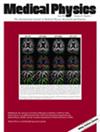Out-of-field neutron radiation from clinical proton, helium, carbon, and oxygen ion beams
Abstract
Background
In hadron therapy, out-of-field doses, which may in the long-term cause secondary cancers, are mostly due to neutrons. Very recently, 4He and 16O beams have been added to protons and 12C ions for clinical therapy.
Purpose
The focus of this article is to compare secondary neutron doses produced by clinical protons, 4He, 12C, and 16O ion beams.
Methods
Ambient dose equivalent, H*(10), measurements were performed, with five types of rem counters, of the neutron field produced by the four primary ions impinging on a water phantom. This experiment was performed at the Heidelberg Ion Beam Therapy Center (HIT) in the framework of the activities of the European Radiation Dosimetry Group (EURADOS). The experimental data are normalized to both unit primary particle and target dose, and are further compared to Monte Carlo (MC) simulations performed with the FLUKA and MCNP codes.
Results
The intensity of the neutron field increases with ion mass, and the trend is more significant in the forward direction. The minimum H*(10) for all ions, 5µSv/Gy to 10µSv/Gy, was measured in the transverse and backward directions, whereas the maximum measured value was about 1.3 mSv/Gy for primary 16O ions in the forward direction. Additional MC simulations are presented for a more detailed analysis of the rem counters’ response in the presence of heavy charged fragments. In the downstream direction, for 12C and 16O ions, approximately only 30% of the instruments’ counts are due to neutrons.
Conclusion
The four extended-range instruments provide reliable and consistent results, whereas the conventional rem counter underestimates H*(10) in a neutron field with a large high-energy component. FLUKA and MCNP provide consistent predictions, within a factor of 1.6 for the downstream position and lower differences in the other cases, and are in agreement with the experimental data. It was found that under certain conditions neutrons do not represent the only secondary radiation field to be monitored; the presence of charged particles affects the performance of moderator-type neutron detectors.


 求助内容:
求助内容: 应助结果提醒方式:
应助结果提醒方式:


